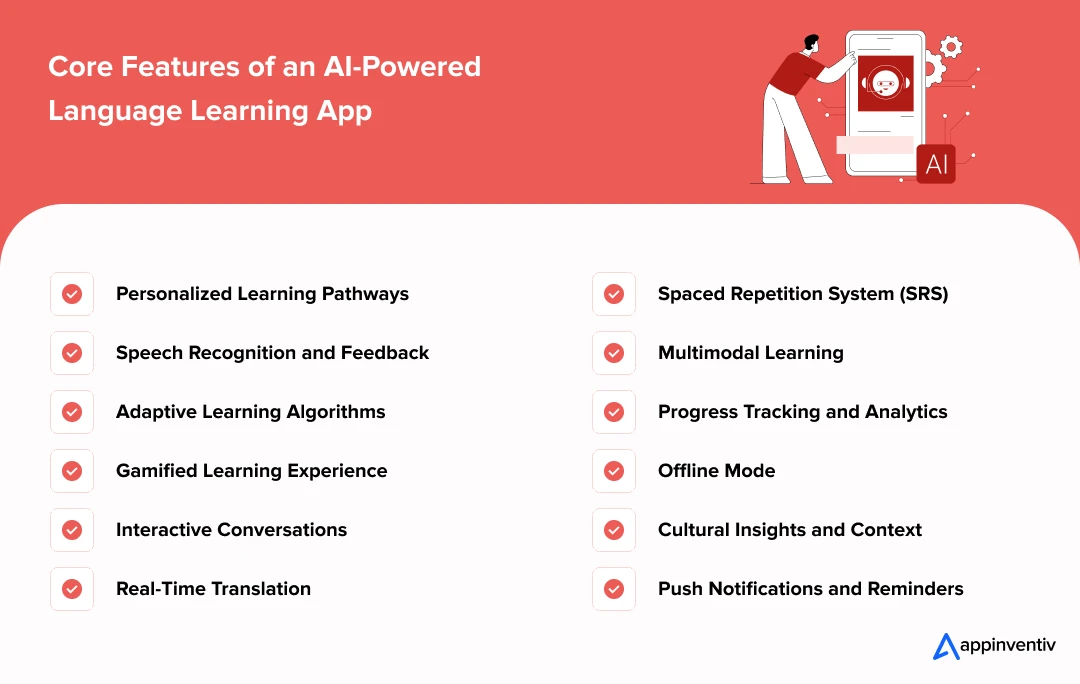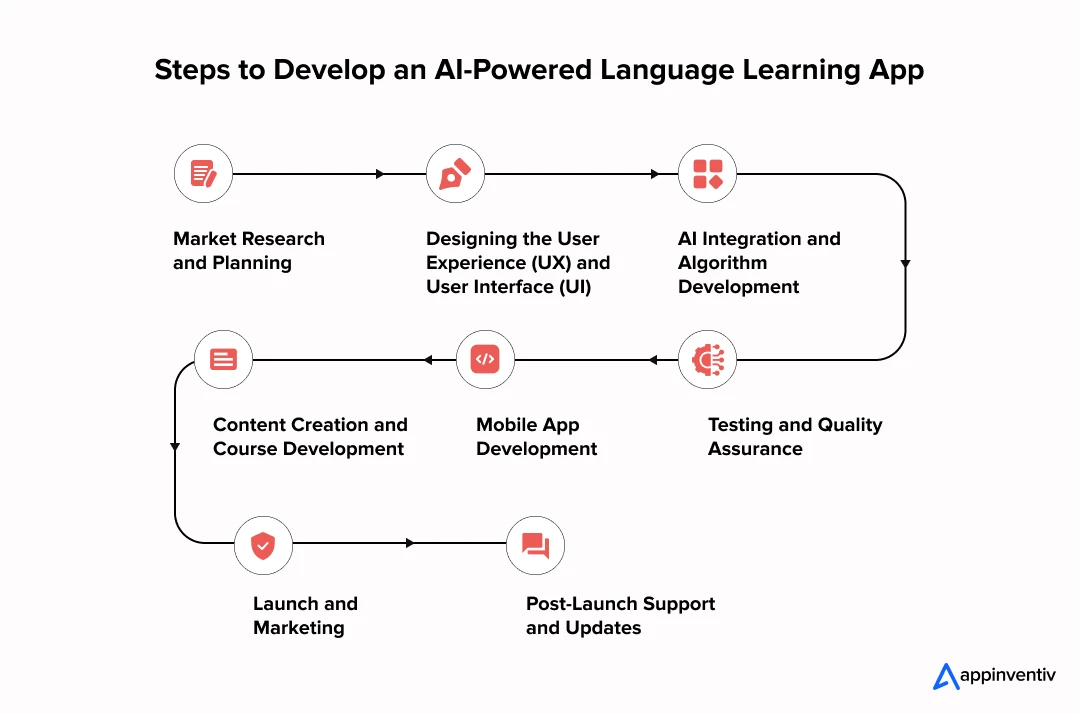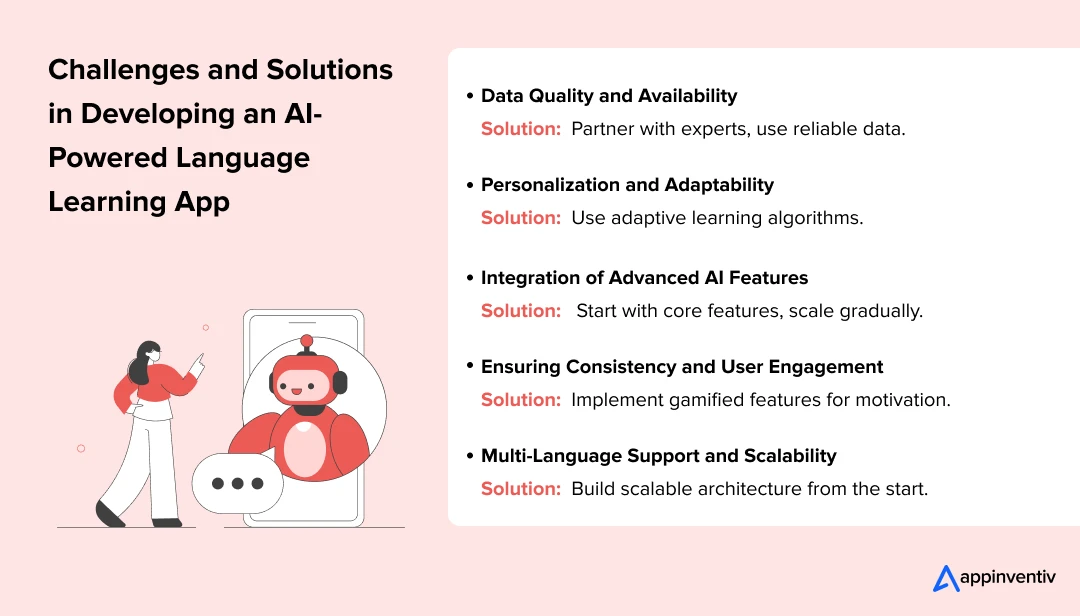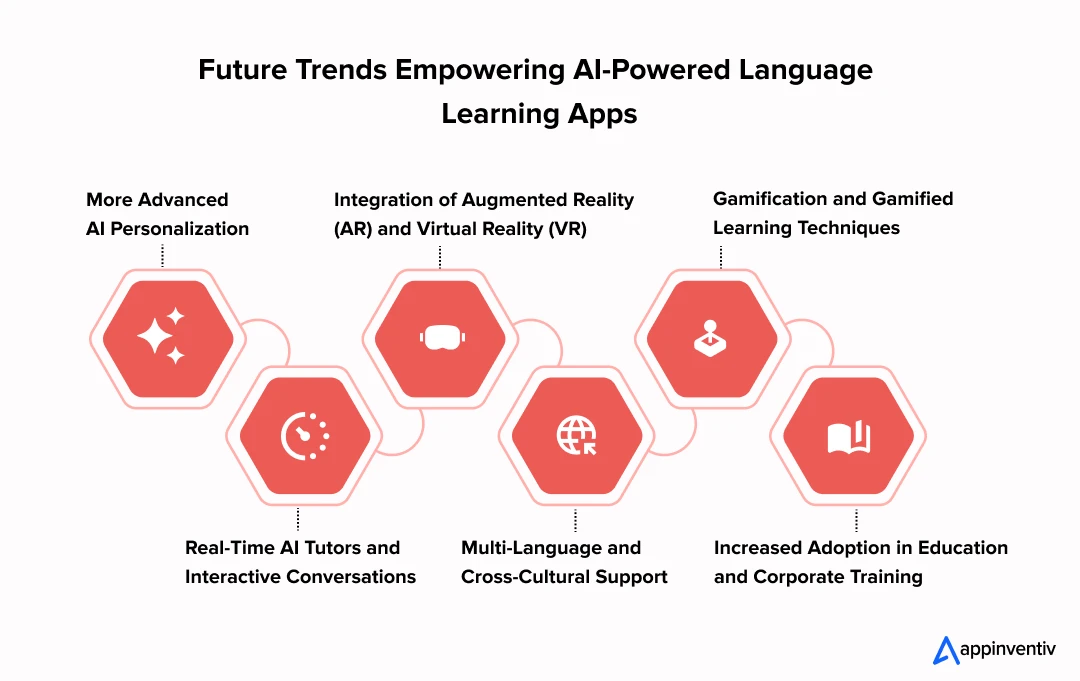- A Brief Glimpse into AI-Powered Language Learning Apps
- Basic Features of an AI Language Learning App
- 1. Personalized Learning Pathways
- 2. Speech Recognition and Feedback
- 3. Adaptive Learning Algorithms
- 4. Gamified Learning Experience
- 5. Interactive Conversations
- 6. Real-Time Translation
- 7. Spaced Repetition System (SRS)
- 8. Multimodal Learning
- 9. Progress Tracking and Analytics
- 10. Offline Mode
- 11. Cultural Insights and Context
- 12. Push Notifications and Reminders
- Advanced Features of an AI-Powered Language Learning App
- 1. Natural Language Processing (NLP) for Contextual Understanding
- 2. AI-Powered Writing Assistance
- 3. Voice Cloning and Advanced Speech Synthesis
- 4. Machine Learning-Driven Personalization
- 5. Real-Time AI Tutoring
- 6. Augmented Reality (AR) Integration
- 7. Smart Vocabulary Builder with Contextual Usage
- 8. Emotional Recognition for Adaptive Learning
- 9. Multilingual Support for Simultaneous Learning
- 10. AI-Based Pronunciation Feedback with Voice Stress Analysis
- How to Develop an AI-Powered Language Learning App?
- 1. Market Research and Planning
- 2. Designing the User Experience (UX) and User Interface (UI)
- 3. AI Integration and Algorithm Development
- 4. Content Creation and Course Development
- 5. Mobile App Development
- 6. Testing and Quality Assurance
- 7. Launch and Marketing
- 8. Post-Launch Support and Updates
- Cost of Developing an AI-Powered Language Learning App
- 1. App Complexity:
- 2. Platform Choice:
- 3. Feature Set:
- Challenges and Solutions in Developing an AI-Powered Language Learning App
- 1. Challenge: Data Quality and Availability
- 2. Challenge: Personalization and Adaptability
- 3. Challenge: Integration of Advanced AI Features
- 4. Challenge: Ensuring Consistency and User Engagement
- 5. Challenge: Multi-Language Support and Scalability
- Future of AI-Powered Language Learning Apps: What Businesses Can Expect
- 1. More Advanced AI Personalization
- 2. Real-Time AI Tutors and Interactive Conversations
- 3. Integration of Augmented Reality (AR) and Virtual Reality (VR)
- 4. Multi-Language and Cross-Cultural Support
- 5. Gamification and Gamified Learning Techniques
- 6. Increased Adoption in Education and Corporate Training
- Why Appinventiv is the Right Partner for Developing an AI-Powered Language Learning App
- FAQs
- AI is transforming language learning with personalized, engaging experiences.
- Building an AI language learning app involves research, design, AI integration, and testing.
- Key features include speech recognition, adaptive learning, and gamification.
- Development costs range from $50,000 to $250,000 based on complexity.
- Advanced features like NLP, AR, and real-time AI tutors enhance the app’s appeal.
- Investing in AI-powered language learning apps can yield high ROI and long-term growth.
AI is dominating the tech world today, not just as a buzzword, but as the powerhouse driving some of the most innovative products and services. From self-driving cars to dynamic content recommendations, AI has unlocked an era of convenience and efficiency that was once only imagined. Now, it’s reshaping how we learn and communicate, making it faster and more intuitive than ever before. In particular, AI language learning apps are at the forefront of this revolution, creating a smarter, more adaptive way to learn languages.
When it comes to language learning, AI-driven language learning apps are revolutionizing the game, turning traditional methods on their head. Gone are the days of dusty textbooks and memorization drills. AI-based language learning apps are here to make mastering a new language feel like second nature. They adapt to your user’s pace, cater to their learning style, and even mimic real-world conversations, offering a dynamic, real-time experience that traditional methods just can’t match.
With the increasing demand for adaptive mobile education solutions and the global rise in language barriers, the market for AI language learning applications is growing rapidly.The opportunities are undeniable. Think about it—whether it’s for business expansion, travel, or personal enrichment, the need to speak multiple languages is more critical than ever. And this is where AI in language learning software steps in, offering learners a smart, effective way to break through those barriers with ease.
So, if you’ve ever thought about diving into the world of AI-powered language learning app development, now is the perfect time. In this blog, we’ll break down everything you need to know: the AI-powered language learning app features, the process of building them, and, of course, the costs involved. Whether you’re a startup looking to make your mark or an entrepreneur with a great idea, this guide will walk you through it all.
Looking to revolutionize the learning experience for your users and unlock new growth opportunities for your business?
Let’s build an AI-powered language learning app that puts you ahead of the curve.
A Brief Glimpse into AI-Powered Language Learning Apps
Education is going through some major changes right now, and artificial intelligence is leading the charge in this whole transformation. McKinsey’s 2024 Global Survey on AI shows that 65% of organizations are now using generative AI on a regular basis – that’s almost twice as many as the year before. This massive jump in AI adoption isn’t just some passing fad; it’s a pretty clear sign that companies in all kinds of industries are finally getting how powerful AI can be for boosting efficiency and growing their businesses.
When it comes to language learning specifically, AI-powered language learning apps are completely changing the game. These platforms use sophisticated algorithms to create personalized learning experiences, give you feedback in real-time, and let you practice languages in really immersive ways. Take apps like Duolingo and Babbel – they’ve woven AI technology into their systems so lessons actually adjust to how fast each person learns, making picking up new languages way more accessible and fun.
People around the world are also hungry for language learning like never before. Statista’s numbers show that language learning apps hit 26.5 million downloads in 2024, with Duolingo alone pulling in $607.53 million just from subscriptions. This explosion in growth comes from things like globalization, more people traveling, and businesses needing employees who can communicate in multiple languages, which makes developing AI language learning apps for education more crucial than ever.
For companies looking at this space, there’s a real goldmine of opportunity here to put money into AI-powered education app development. When businesses either build or start using these kinds of applications, they can jump into a market that’s growing fast, make their product lineup stronger, and actually give consumers what they’re looking for – language learning applications that are both efficient and tailored to their individual needs.
Basic Features of an AI Language Learning App
AI-powered language learning apps are transforming how we acquire new languages by offering personalized, adaptive, and immersive experiences. These apps leverage cutting-edge technology to ensure learning is not only efficient but also engaging.

1. Personalized Learning Pathways
What makes AI language learning apps really stand out is how they build custom learning plans that actually fit each person’s progress, what they’re good at, and where they need work. This means every learner gets an experience that’s shaped around their specific needs, which makes picking up a new language way more effective.
2. Speech Recognition and Feedback
AI-powered language apps tap into some pretty impressive speech recognition tech to help people practice how they sound. The app actually listens when you speak and gives you feedback right on the spot, making it much easier to work on your accent and clarity without having to find a human tutor.
[Also Read: How much does it cost to build an AI voice generator and text-to-speech reader app like Speechify?]
3. Adaptive Learning Algorithms
These apps are constantly watching how well you’re doing and adjusting how hard the lessons are based on that. When you’re crushing it, the app throws more challenging stuff your way, but if you’re having trouble, it gives you extra review sessions to help strengthen those weak spots.
[Also Read: Use Cases and Examples of How Adaptive AI is Transforming Industries]
4. Gamified Learning Experience
Tons of AI-based language learning apps throw in game-like features to keep people motivated and coming back. Things like badges, points, leaderboards, and challenges make users want to keep going while turning the whole learning process into something that’s actually fun instead of feeling like work.
5. Interactive Conversations
AI-powered language learning apps often create realistic conversations using chatbots or virtual tutors. These practice sessions let learners work on their speaking and listening skills in a comfortable, engaging setting without the stress of talking to an actual person.
6. Real-Time Translation
Best AI language learning apps usually include instant translation features, so users can translate words or sentences on the fly while they’re learning. This helps people build up their vocabulary and really understand the language better by seeing how translations work in actual context.
7. Spaced Repetition System (SRS)
To help people actually remember what they learn, many of the best AI-powered language learning apps use spaced repetition algorithms. These systems bring back vocabulary and grammar at carefully timed intervals, helping learners stick words and phrases into their long-term memory.
8. Multimodal Learning
AI apps work with different learning styles by offering text, audio, video, and hands-on exercises. Whether someone learns best by hearing things, reading, or seeing visuals, the app adjusts to provide different types of content that keep users interested and help nail down what they’re learning.
9. Progress Tracking and Analytics
Most AI-driven language learning apps give you detailed reports on how you’re doing, keeping track of your vocabulary, fluency, speaking, and listening skills as time goes on. These AI analytics let users see how much they’ve improved and figure out what areas still need attention, giving them a clear roadmap toward actually mastering the language.
10. Offline Mode
Many AI-based language learning apps let you keep learning even when you don’t have internet access. This makes it super easy for people to practice whenever and wherever they want, whether they’re on the train to work or traveling somewhere with spotty WiFi.
11. Cultural Insights and Context
AI-powered apps often weave in lessons about culture and context around how the language is actually used. Learners get to understand not just the words and grammar, but also the cultural stuff, slang, and expressions that make the language feel natural and useful in real conversations.
12. Push Notifications and Reminders
To keep learners motivated and sticking with it, AI language apps send out reminders and little nudges. These gentle prompts help users stay consistent with their learning habits and make it easy to keep up regular practice without losing steam.
Advanced Features of an AI-Powered Language Learning App
Beyond the core features, AI-powered language learning apps incorporate advanced tools that enhance the user experience, making learning even more efficient and immersive. These features leverage the power of AI to simulate real-world environments, offer deeper insights, and enable more sophisticated learning techniques.

1. Natural Language Processing (NLP) for Contextual Understanding
AI apps that use Natural Language Processing (NLP) can actually understand what users are saying in a way that feels much more human. This creates more natural back-and-forth conversations because the app gets context, picks up on slang, understands sayings and expressions, and even recognizes different regional ways of speaking, making the whole learning experience feel way more genuine.
2. AI-Powered Writing Assistance
More sophisticated apps come with features that help people polish their writing skills in their target language. Through AI, these apps can give suggestions for better grammar, smarter vocabulary choices, and cleaner sentence structure. This lets learners put together more polished and accurate writing, whether they’re working on essays or emails in the language they’re studying.
3. Voice Cloning and Advanced Speech Synthesis
Some AI-driven apps offer really advanced speech technology and voice cloning that lets users hear exactly how native speakers say words and sentences. These apps can even copy different accents and tones, giving users a much better sense of how pronunciation changes from region to region and all the different ways people actually speak.
4. Machine Learning-Driven Personalization
Sophisticated machine learning algorithms let the app keep getting smarter based on how each person uses it. The app picks up on interactions, tweaks learning paths, and can even predict what challenges someone might run into down the road. This kind of personalized learning approach makes both engagement and actual language skills way better.
5. Real-Time AI Tutoring
Using deep learning models, some apps have real-time AI tutors that create personalized language lessons on the spot. These tutors can have live conversations, catch mistakes as they happen, and give detailed explanations, creating a much more interactive and immersive way to learn.
6. Augmented Reality (AR) Integration
Some of the most cutting-edge AI language learning apps bring in Augmented Reality (AR) to mix the digital world with the real world around you. Users can interact with virtual objects or scenes while practicing their language skills, like labeling things in their actual environment using their target language or doing AR-powered language exercises.
7. Smart Vocabulary Builder with Contextual Usage
AI apps can help learners with smart vocabulary builders that don’t just give you translations but actually show you how words are used in real situations. This feature lets users see how words and phrases work in different contexts, helping them understand the subtle differences and avoid making mistakes when they’re actually using the language.
8. Emotional Recognition for Adaptive Learning
Some advanced language apps use AI to read facial expressions or listen to voice tone, featuring emotion recognition to figure out how engaged or stressed a user is. This lets the app adjust how hard things are and give real-time encouragement or extra challenges based on whether the learner seems motivated or getting frustrated.
9. Multilingual Support for Simultaneous Learning
Advanced AI apps can handle multilingual learning, letting users tackle multiple languages at the same time. This is really helpful for people who want to master more than one language simultaneously, letting them jump between languages smoothly while keeping up an efficient learning rhythm.
10. AI-Based Pronunciation Feedback with Voice Stress Analysis
Some cutting-edge language apps take AI-powered pronunciation feedback to the next level by not just checking if you said a word right, but also analyzing the stress patterns and rhythm in how you speak. This helps users fine-tune their speaking skills to sound more like native speakers, giving them a much deeper level of control over the language.
Looking to take your AI-powered language learning app to the next level?
We can help you add cutting-edge features like real-time AI tutors, AR, and personalized learning paths to make your app truly unique.
How to Develop an AI-Powered Language Learning App?
Developing an AI-powered language learning app is an intricate process that involves several stages, from ideation to launch. It requires careful planning, a solid understanding of AI technology, and a focus on creating an intuitive, engaging user experience. Below is a step-by-step breakdown of the AI language learning app development process, designed to help you understand what goes into building such a platform.

1. Market Research and Planning
The first step in developing language learning apps with AI is to conduct thorough market research. This involves understanding your target audience, identifying the most popular languages, and analyzing competitors. You’ll also need to define the features and functionalities of your AI-based language learning app, ensuring they meet the expectations of modern learners. Based on the research, you’ll plan the app’s design, user interface, and learning pathways.
2. Designing the User Experience (UX) and User Interface (UI)
Creating an intuitive user experience (UX) is crucial for the success of an AI-driven language learning app. At this stage, wireframes and prototypes are developed to map out how users will navigate the app and interact with various learning features. The UI design focuses on the visual appeal, making sure the design is both user-friendly and aligned with the overall brand.
3. AI Integration and Algorithm Development
The core of any AI-powered language learning app is the integration of AI algorithms that drive personalization and interactivity. This stage involves developing machine learning algorithms that analyze user data, adapt lessons, and provide real-time feedback. The app will need a robust natural language processing (NLP) engine for speech recognition and comprehension. AI models will also be developed to offer personalized learning paths based on a user’s strengths and weaknesses.
4. Content Creation and Course Development
To ensure your app is not only functional but educational, you need to create relevant and engaging content. This may include designing lessons, quizzes, videos, and interactive activities. The content must be tailored to different proficiency levels and learning goals. Moreover, the AI language learning app development team will need to ensure that the content aligns with the latest language learning best practices, such as using spaced repetition and contextual exercises.
5. Mobile App Development
During this stage of language learning app development using AI, the actual coding and app development take place. Whether you are developing an AI language learning app for education on iOS or Android, the development team will use languages like Swift, Kotlin, or React Native to create a seamless, cross-platform app. The backend is built to handle user data, AI processing, and real-time performance, while the frontend ensures smooth interaction with all AI-powered language learning app features.
6. Testing and Quality Assurance
Once the app has been developed, it’s time to test it. The QA process includes testing the AI algorithms for accuracy and efficiency, ensuring smooth performance, and checking the usability of the app. The app’s AI features—such as voice recognition, feedback systems, and personalized learning pathways—will be thoroughly tested to ensure they provide a smooth and error-free experience. Security measures, particularly around user data, are also tested.
7. Launch and Marketing
After rigorous testing, the app is ready for launch. The marketing phase focuses on promoting the app to the target audience through digital campaigns, social media, and influencer partnerships. Additionally, app store optimization (ASO) will play a key role in driving visibility. During this phase, the AI-powered language learning app features are highlighted to demonstrate how the app can make language learning easier and more personalized.
8. Post-Launch Support and Updates
Even after launch, the development process doesn’t end. Continuous monitoring is essential to gather user feedback, fix any bugs, and release updates. In this phase, you’ll also want to improve and evolve the AI algorithms as new data is gathered. Regular updates should include adding new languages, improving AI language learning applications, and enhancing the learning experience based on user behavior.
Cost of Developing an AI-Powered Language Learning App
The cost to develop an AI language learning app typically ranges from $50,000 to $250,000, depending on several key factors, including app complexity, platform choice, and the features you plan to include.
Basic AI-based language learning apps with essential features like progress tracking, quizzes, and speech recognition typically cost between $50,000 and $100,000. In contrast, more advanced apps with sophisticated AI features, such as real-time AI tutoring, natural language processing (NLP), and augmented reality (AR), can cost between $150,000 to $250,000 or more.
Here’s a breakdown of the key factors that affect the total cost of AI language learning app development:
1. App Complexity:
The complexity of the app is a significant factor in determining the cost of AI app development for language learning. A basic AI-powered language learning app with essential features will be less expensive than an app that incorporates advanced AI-driven language learning app features.
Basic Apps: $50,000 to $100,000
Intermediate Apps: $100,000 to $175,000
Advanced Apps with AI Features: $175,000 to $250,000
2. Platform Choice:
The platform(s) you choose (iOS, Android, or both) will affect the overall development cost. Developing for a single platform is less costly than building an app for both platforms.
Single Platform (iOS or Android): $10,000 to $30,000
Cross-Platform (iOS + Android): $30,000 to $50,000
3. Feature Set:
The AI language learning app features you decide to integrate will significantly impact the cost. Basic features like progress tracking, quizzes, and user profiles are less expensive, whereas advanced features such as speech recognition, NLP, real-time AI tutoring, and AR will increase costs.
Basic Features (Progress tracking, quizzes, etc.): $20,000 to $40,000
Advanced Features (Speech recognition, NLP, real-time AI tutoring, AR): $40,000 to $100,000

For example, if you’re developing an AI-powered language learning app for education with intermediate features, for both iOS and Android:
Base Cost (Intermediate App): $100,000
Platform Cost (Cross-Platform): $30,000
Feature Cost (Basic Features + Speech Recognition): $40,000
Total Estimated Cost = $100,000 + $30,000 + $40,000 = $170,000
This formula helps you estimate the cost of AI language learning app development, but keep in mind that ongoing maintenance and future updates will also add to the long-term cost of developing language learning apps with AI.
[Also Read: How Much Does it Cost to Develop a Language Learning app like Babbel]
Challenges and Solutions in Developing an AI-Powered Language Learning App
Developing an AI-powered language learning app comes with its own set of challenges. While the potential for innovation is vast, overcoming these hurdles is crucial to ensuring your app’s success. Let’s discuss some common challenges faced during the AI language learning app development process and how to address them effectively.

1. Challenge: Data Quality and Availability
Obtaining high-quality data for training AI models can be difficult, affecting the app’s accuracy in translations and feedback.
Solution:
Partner with dedicated AI services and solutions experts and use reputable data sources to ensure robust AI language learning app development and continuous model improvement.
2. Challenge: Personalization and Adaptability
Creating an app that effectively personalizes learning paths for diverse user needs is complex and resource-intensive.
Solution:
Incorporate adaptive learning algorithms that monitor progress and adjust lessons based on user performance, ensuring a personalized experience.
3. Challenge: Integration of Advanced AI Features
Adding features like speech recognition and NLP can increase development time and costs.
Solution:
Start with core features and gradually integrate advanced AI capabilities, leveraging pre-built AI language learning applications for cost and time efficiency.
4. Challenge: Ensuring Consistency and User Engagement
Maintaining engagement over time can be challenging, leading to potential user drop-off.
Solution:
Implement gamified learning experiences with rewards and progress tracking to keep users motivated and engaged.
5. Challenge: Multi-Language Support and Scalability
Scaling the app and supporting multiple languages can be complex and resource-heavy.
Solution:
Build a flexible and scalable architecture from the start, allowing for easy integration of additional languages and expansion.
Future of AI-Powered Language Learning Apps: What Businesses Can Expect
The future of AI-powered language learning apps is promising, with continual advancements in AI technology paving the way for more efficient, engaging, and personalized learning experiences. As AI continues to evolve, businesses in the language learning sector can expect significant growth and innovation.

1. More Advanced AI Personalization
The future of AI-based language learning apps will see even more sophisticated personalization. With the help of machine learning, these apps will be able to assess users’ behavior, learning styles, and preferences in real-time to offer a fully customized learning experience, helping users progress faster and more efficiently.
[Also Read: 12 Ways AI in Education is Transforming the Industry]
2. Real-Time AI Tutors and Interactive Conversations
Expect AI language learning apps to offer more advanced real-time AI tutors capable of engaging in natural, fluid conversations with users. These interactive features will help learners practice speaking in real-world scenarios, making language learning more practical and immersive than ever before.
3. Integration of Augmented Reality (AR) and Virtual Reality (VR)
AI-driven language learning apps are likely to integrate more AR and VR technologies to create immersive, interactive environments for learners. This technology will enable users to practice language skills in realistic settings, such as virtual marketplaces or restaurants, for a truly hands-on experience.
4. Multi-Language and Cross-Cultural Support
In the future, AI-powered language learning apps will support an even broader range of languages and dialects, allowing businesses to reach a global audience. With the addition of regional cultural nuances, these apps will offer a more holistic learning experience that extends beyond just language to cultural understanding.
5. Gamification and Gamified Learning Techniques
The role of AI language learning apps for education will expand in terms of gamified learning. Expect businesses to incorporate more engaging game-like features—such as challenges, leaderboards, and rewards—into their apps to enhance motivation, improve user retention, and make learning a more enjoyable experience.
6. Increased Adoption in Education and Corporate Training
AI language learning apps will become an essential tool not only for individual learners but also for educational institutions and businesses. From schools to corporations, these apps will be adopted widely for training employees, improving multilingual communication, and enhancing professional development in global markets.
Why Appinventiv is the Right Partner for Developing an AI-Powered Language Learning App
We hope this blog has helped you understand the potential of AI-powered language learning apps and the opportunities they present. If you’re ready to bring your app idea to life, Appinventiv is the right partner for the job.
With our expertise in AI language learning app development, we specialize in integrating advanced features like speech recognition, NLP, and personalized learning paths. We ensure that your app is both scalable and user-friendly, with the right balance of AI-driven capabilities and seamless functionality.
As a renowned AI development services provider, we also focus on enhancing user engagement through features like gamification and real-time AI tutoring, ensuring that learners stay motivated and connected. Our team stays ahead of the curve with continuous updates and cutting-edge solutions.
With Appinventiv, you get a dedicated partner that understands both the technical and strategic aspects of building AI-powered education apps. Let us help you create a language learning app that stands out in a growing market.
FAQs
Q. How much does it cost to develop an AI language app?
A. The cost to develop an AI language learning app can range from $50,000 to $250,000, depending on the complexity, platform, and features included. Basic apps with essential functionalities such as progress tracking and quizzes fall on the lower end of the scale, while apps with advanced features like speech recognition, NLP, and real-time AI tutoring can push the cost higher. Factors like the team’s location and the platform (iOS, Android, or cross-platform) also influence the final development cost.
Q. What are the key features of AI language learning apps?
A. The key features of AI-based language learning apps include:
- Personalized Learning Paths
- Speech Recognition
- Adaptive Learning Algorithms
- Gamification Elements
- Real-Time Interactive Conversations
These features are designed to make the learning experience more efficient, personalized, and engaging. Speech recognition helps learners improve pronunciation, while adaptive learning algorithms ensure the content adjusts to the user’s progress. Gamified elements and real-time interactive conversations keep learners motivated and allow them to practice in realistic scenarios.
Q. How AI is revolutionizing language learning apps?
A. AI is revolutionizing language learning applications by making learning more personalized, adaptive, and accessible. With the help of AI-driven language learning app features, such as speech recognition and NLP, apps are now able to offer real-time feedback, tailor lessons to individual needs, and provide immersive learning experiences. AI also enables continuous improvement, ensuring that apps evolve based on user interactions and learning patterns. This makes language learning not only more effective but also more enjoyable for users.



Practical Applications of AI as a Service for Your Business
Key takeaways: AIaaS enables fast, infrastructure-free AI adoption. Used across industries for automation and insights. Real-world examples show proven business impact. Pilot-first approach ensures smooth implementation. Key challenges include data, cost, and scaling. Trends include ethical AI, edge, and SME growth Imagine being able to cut down your operational costs while simultaneously improving decision-making and…

How AI is Revolutionizing Data Governance for Enterprises and How to Do It Right?
Key takeaways: Outdated Governance: Traditional, rule-based governance is ineffective for today's complex data ecosystems. AI as Augmentation: AI enhances, rather than replaces, human oversight by providing intelligence that can learn and adapt. Proactive Risk Management: It shifts compliance from reactive audits to predicting and managing risks before they materialize. Significant Market Growth: The data governance…

AI in Biotech: 10 Proven Benefits and Use Cases That Are Transforming the Life Sciences Industry
Key takeaways: AI transforms biotech: AI streamlines drug discovery, personalized medicine, diagnostics, and bioprocessing, significantly reducing time and costs. Real-world impact: Institutions like Mount Sinai and Johns Hopkins leverage AI for drug discovery and clinical applications, driving healthcare innovation. Market growth: The pharmaceutical AI market is projected to grow from $1.94 billion in 2025 to…

















